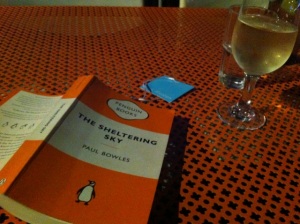I have loved the phrase ‘book voyeurs’ since I read about it in the Guardian ages ago. David Barnett writes:
I think it was Sarah Crown who first set me off. “Is it just me?” she asked (while accepting the cliche of that opening phrase), “is it just me, or are the contents of other people’s bookshelves/bedside tables/desks/whatever ALWAYS more interesting than your own?”
Well, is it just me, or … look, does anyone else have an unhealthy obsession not just with what people have on their bookshelves but what they’re actually reading right there and then?
I used the concept to create a couple of posts here and here on what I was reading; ‘Reading Notes for Book Voyeurs‘, an ‘occasional series’, I called it. Very occasional, as it turns out. I do weave my reading in and out of my blog posts, so perhaps this is why it seems more, but there it is, a series of two! Time to pick up the pace here, it seems for all the book voyeurs amongst us.
Reading is one of the great loves of my life. I have toyed with the idea of a separate book and reading blog, but the general advice I have gleaned out there is ‘don’t start a second blog’. I also have trouble with managing the time and content for one, so not keen to try and manage two. So I’m working with the concept that this blog is about my theme of transcending and what helps rise above, cut through, triumph over the negative and overcome, and I include books and reading here.
If anything has had the power to help me move through, overcome, make sense of and negotiate the world, it has been books and reading. A large part of my life has been dedicated to honing my skills in this area, personally and through studying literature, literacy and language; my career path includes being a teacher of reading and writing to adults, so this theme runs strong.
I find it helps to have a theme and focus, a meaningful reading project, to anchor my love of reading in a busy stream of activity. This year’s reading project is the ‘Australian Women Writer’s 2012 Reading and Reviewing Challenge‘. I have chosen to read 10 books in a range of genres and review 4 of them. I’m loving the AWW 2012 challenge and the community and activity it’s inspiring. Having a long and enduring love of Australian literature and women’s writing, it’s been wonderful to connect with this space again. Designed to refocus and re-engage people with the writing of Australian women, the challenge has been wildly successful with 1000+ review, a great website, twitter feed, Goodreads site and a rich community of readers and writers to engage with.
I’ve so far read 5 of my 10 works by Australian women writers this year and have just started my sixth today. I am sure I would not have become aware of some of these books if not for the challenge and being more generally attuned to the work of Australian women writers. Plus I’ve connected with some fabulous bloggers and writers who share my love of Australian literature and good writing.
So far, I have read:
Searching for the Secret River: A Writing Memoir, Kate Grenville
When we have Wings, Claire Corbett
Sarah Thornhill, Kate Grenville
The Light Between Oceans, M. L. Stedman
Poet’s Cottage, Josephine Pennicott
And I’ve just started the gorgeously suspenseful, ‘The Engagement‘ by Chloe Hooper.
The reviews are yet to come and are in the planning stages and yes, I need to get onto them as the year is marching away. I started to work on my review of ‘Searching for the Secret River’ with some research on the net, and found I had quite forgotten the furore around history and literature that surrounded ‘The Secret River’ in 2006 and must admit that minefield put me off and somewhat stalled my review writing.
In any case, I will work on my planned review mindful of the background issues, but my reading of both ‘The Secret River’ and ‘Searching for the Secret River’ was positive, tapping as both books do into my key interests of family history research, writing about this, trying to gauge what might have happened in the spaces of fact, if imperfectly, and understanding also that writing novels in historical contexts requires some fictionalising.
All this made me reconsider the act of book reviewing in the context of this blog and also AWW2012, and what form the reviews should or could take. I guess this may be part of the challenge of the Australian Women Writers Challenge for me: finding a meaningful way to write about these works that fits with my theme of ‘Transcending’ here and honours the tradition of resilience that these books are borne from, with Miles Franklin, the pioneering Australian women writer as its symbol and inspiration,
I’d best get back to reading the very engaging, ‘The Engagement’ and also working on those book reviews but I welcome your comments on:
- books and reading as part of ‘Transcending’
- your experience of books and reading and how they have helped you overcome, move through
- book reviews and blogging generally – how can they come together?




